16
RODEO EVENTS
RODEO EVENTS
DAYS OF ACTION
IN PRIZE MONEY
Kid’s Zone at the North Ball Diamonds
starts every day at 12:00 PM
featuring bouncy castles, face painting, a petting zoo and
Make Your Own Brand with the Stockmen’s Memorial Foundation
Food Trucks open daily at 11:00 AM
Beer Gardens on the hillside opens daily at 12:00 PM
Daily Events Include:
Bareback
Bull Riding
Junior Barrel Racing
Junior Breakaway
Junior Bull Riding
Junior Steer Riding
Ladies Barrel Racing
Ladies Breakaway Roping
Lil Rascals Barrel Racing
Novice Horse Riding
Saddle Bronc
Steer Wrestling
Team Roping
Tie Down Roping
8:00 AM – Flapjack Fest presented by Stockmen’s Memorial Foundation
Live Music and Vendors
5:00 PM – Slimdor Ranch Rodeo
Free Admission courtesy of Slimdor
11:00 AM – Gates Open
Rodeo action begins at 1:00 PM
including the Volunteer of the Year Award
Rodeo Queen Crowning
Special Western Event Demonstration
Rodeo Cabaret featuring TC and Company
Doors open at 7:00 PM
Music starts at 8:00 PM
11:00 AM – Gates Open
Rodeo action begins at 1:00 PM
including the Cowboy of the Year Award
Lion’s Special Awards
Wild Cow Race
11:00 AM – Gates Open
Rodeo action begins at 1:00 PM
Final day of rodeo action
Wild Cow Race

In the Bareback event, the rider holds on to the leather handhold of a rigging—a pad wrapped around the bucking horse’s girth—as he first extends his feet far forward. He then pulls his feet back up toward the rigging in a spurring motion. The higher the spurs, the higher the score.
The stress on the cowboy’s arm is intense as it absorbs most of the horse’s power, but he needs to hold on for at least 8 seconds.
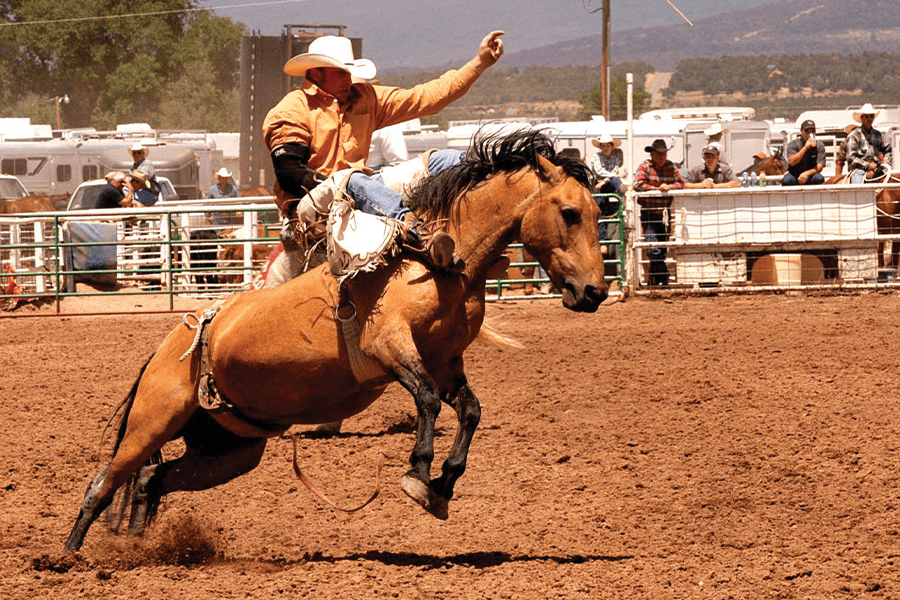
Rhythm between a cowboy and his horse is key in Saddle Bronc.
The rider moves his feet from the horse’s neck toward the back of the saddle, in time with the bronc’s bucking action. The cowboy holds on to a braided rein that is connected to the horse’s halter, using it to help balance himself. If his hand placement is too low on the rein, he could be pulled over the front; too high, and he may be bucked off the back before his eight seconds are up.

In the world-renowned Calgary Stampede bull riding, cowboys engage in a test of nerves against a bull.
A thick braided bullrope, complete with handhold, is wrapped around the bull and weighed down by a cowbell that allows the rope to fall when the ride is over. The rope is only kept tight by the bull rider’s grip.
He must try to keep his arm from straightening and his hand from breaking loose before the end of the ride. The cowboy isn’t required to move his feet—staying on is hard enough—but if he does spur, he gets higher marks.

Junior steer riders is competition for contestants aged 12–15. As in other roughstock events, half of the score is awarded for the cowboy’s ability to ride, and half for the stock’s ability to buck.
Contestants are allowed to ride with one or both hands. If they choose to ride one-handed, they’ll have to abide by the rules of bull riding—they’ll be disqualified for touching the animal or themselves with their free hand, or for grabbing with both hands during the eight seconds.
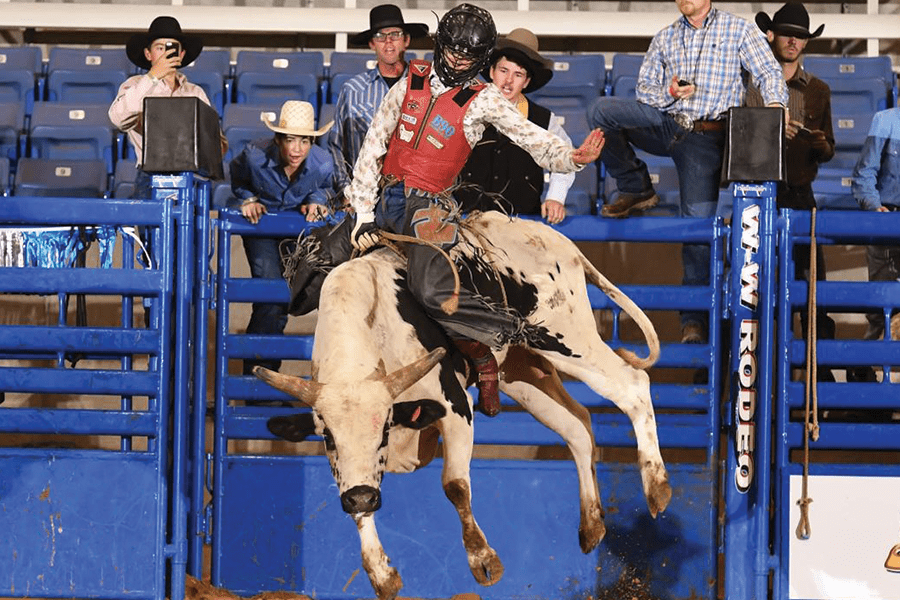
In the world-renowned Calgary Stampede bull riding, cowboys engage in a test of nerves against a bull.
A thick braided bullrope, complete with handhold, is wrapped around the bull and weighed down by a cowbell that allows the rope to fall when the ride is over. The rope is only kept tight by the bull rider’s grip.
He must try to keep his arm from straightening and his hand from breaking loose before the end of the ride. The cowboy isn’t required to move his feet—staying on is hard enough—but if he does spur, he gets higher marks.
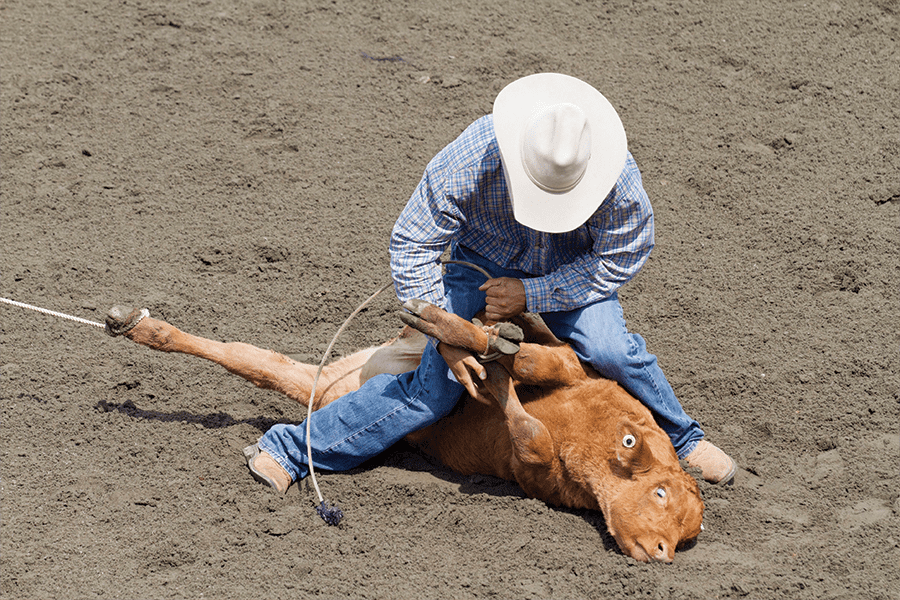
In Tie-Down Roping, the cowboy and his equine partner re-create one of ranching’s oldest tasks: roping and tying an animal.
Speed, skill, and finesse are key in this event. The cowboy waits on horseback behind a rope barrier. When he gives a nod, the calf is released and gets a 10-ft. head start.
The cowboy must quickly rope the calf, dismount on the run to reach it, turn it on its side, and tie three of its legs. Time is called when the cowboy throws his hands in the air, and the calf is immediately released.

Team roping also known as heading and heeling is a rodeo event that features a steer and two mounted riders. The first roper is referred to as the “header”, the person who ropes the front of the steer, usually around the horns, but it is also legal for the rope to go around the neck, or go around one horn and the nose resulting in what they call a “half head”. Once the steer is caught by one of the three legal head catches, the header must dally (wrap the rope around the rubber covered saddle horn) and use his horse to turn the steer to the left.
The second roper is the “heeler”, who ropes the steer by its hind feet after the “header” has turned the steer, with a five-second penalty assessed to the end time if only one leg is caught. Team roping is the only rodeo event where men and women compete equally together in professionally sanctioned competition
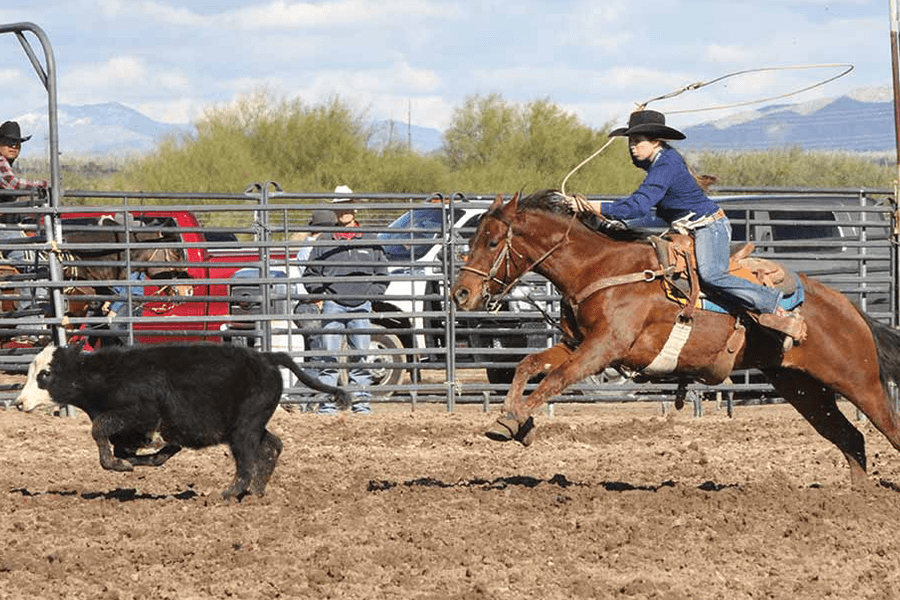
Breakaway roping is an equine sport developed in the Western United States in which a person horseback ropes a calf around the neck, with the roper’s rope “breaking away” from the saddle once the calf is far enough away from the horse.
In breakaway roping, a calf is loaded into the roping chute and the roper enters the box on the right side (heeler’s side) of the roping chute. The breakaway roper waits in the corner of the box, with the calf in the chute, until his or her horse is standing squarely looking ahead. Then, the roper nods his or her head, and a chute operator opens the gate, allowing the calf to enter the arena.
In most competition, a small rope is looped around the calf’s neck, connected to the rope barrier in front of the roper and his or her horse. That rope barrier breaks when the calf runs far enough from the chute, insuring he has a head start on the horse and roper. When the force of the calf leaving the chute releases the neck rope, the roper may leave the box. Leaving the box early and “breaking the barrier” generally results in a 10-second penalty.

Breakaway roping is an equine sport developed in the Western United States in which a person horseback ropes a calf around the neck, with the roper’s rope “breaking away” from the saddle once the calf is far enough away from the horse.
In breakaway roping, a calf is loaded into the roping chute and the roper enters the box on the right side (heeler’s side) of the roping chute. The breakaway roper waits in the corner of the box, with the calf in the chute, until his or her horse is standing squarely looking ahead. Then, the roper nods his or her head, and a chute operator opens the gate, allowing the calf to enter the arena.
In most competition, a small rope is looped around the calf’s neck, connected to the rope barrier in front of the roper and his or her horse. That rope barrier breaks when the calf runs far enough from the chute, insuring he has a head start on the horse and roper. When the force of the calf leaving the chute releases the neck rope, the roper may leave the box. Leaving the box early and “breaking the barrier” generally results in a 10-second penalty.
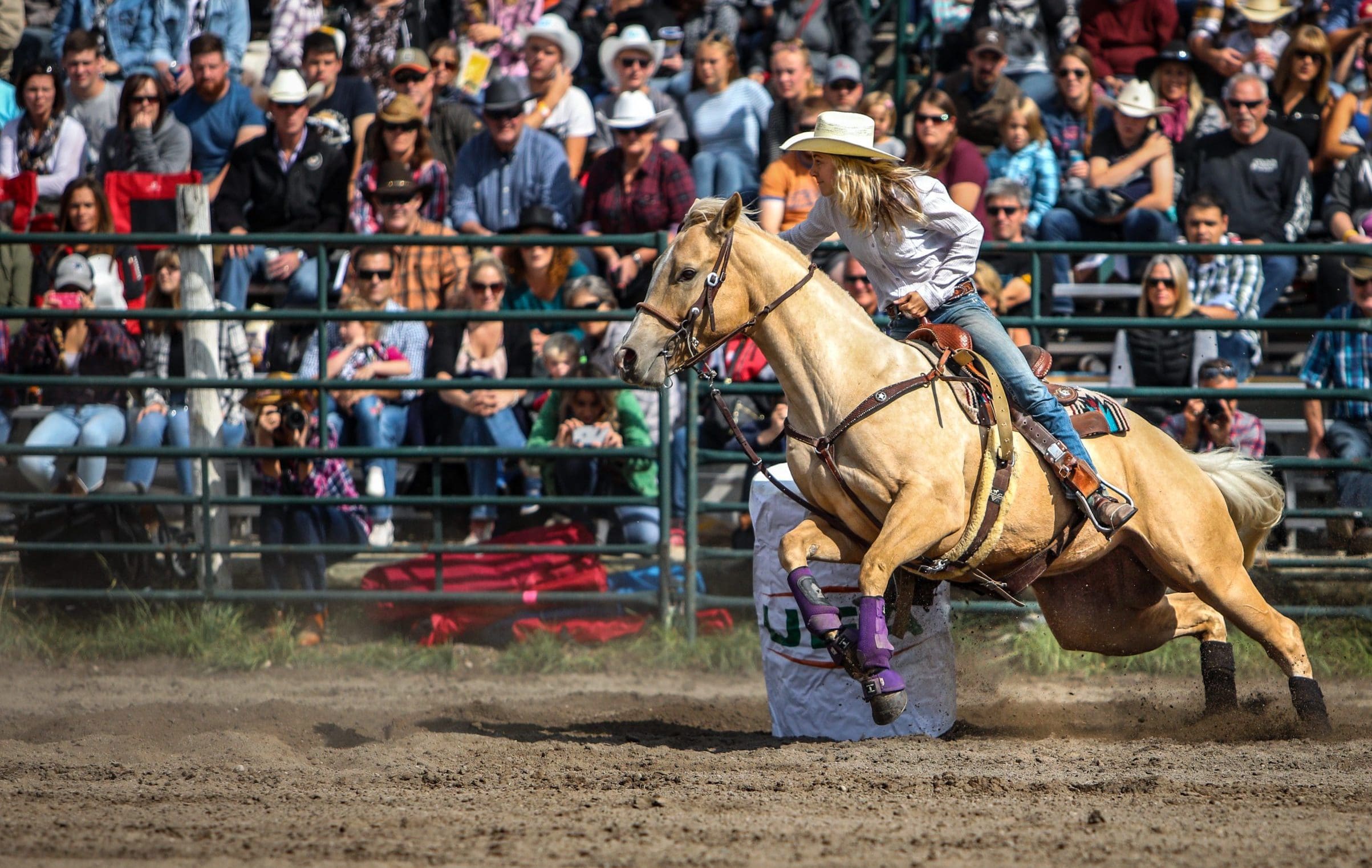
This event requires control, attention to detail, and a close partnership between horse and rider. Competing against the clock, contestants circle three barrels in a cloverleaf pattern and race back across the scoreline. Time is measured with an electronic eye timer, and a hundredth of a second can determine who wins. A rider may touch a barrel, but if she knocks one over a five-second penalty is added to her total time.

This event requires control, attention to detail, and a close partnership between horse and rider. Competing against the clock, contestants circle three barrels in a cloverleaf pattern and race back across the scoreline. Time is measured with an electronic eye timer, and a hundredth of a second can determine who wins. A rider may touch a barrel, but if she knocks one over a five-second penalty is added to her total time.

This event requires control, attention to detail, and a close partnership between horse and rider. Competing against the clock, contestants circle three barrels in a cloverleaf pattern and race back across the scoreline. Time is measured with an electronic eye timer, and a hundredth of a second can determine who wins. A rider may touch a barrel, but if she knocks one over a five-second penalty is added to her total time.
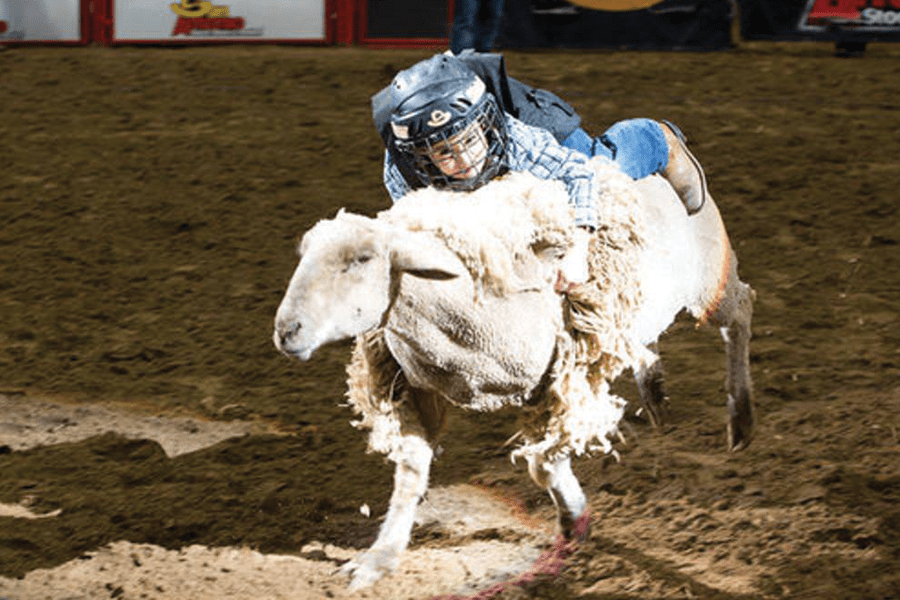
In the event, a sheep is held still, either in a small chute or by an adult handler while a child is placed on top in a riding position. Once the child is seated atop the sheep, the sheep is released and usually starts to run in an attempt to get the child off.
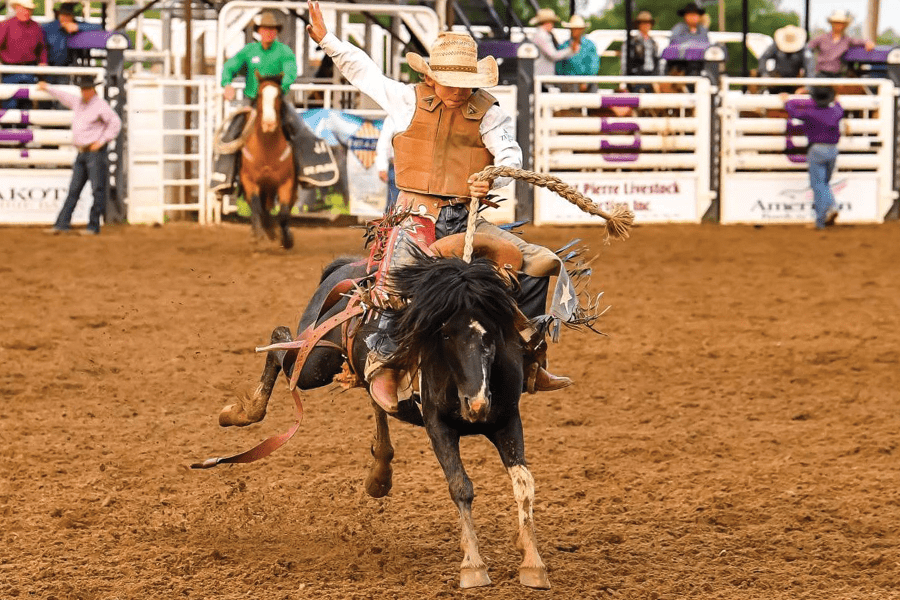
Rhythm between a cowboy and his horse is key in Saddle Bronc. This event features 8 – 12 year olds and they are riding mini horses.
The rider moves his feet from the horse’s neck toward the back of the saddle, in time with the bronc’s bucking action. The cowboy holds on to a braided rein that is connected to the horse’s halter, using it to help balance himself. If his hand placement is too low on the rein, he could be pulled over the front; too high, and he may be bucked off the back before his eight seconds are up.
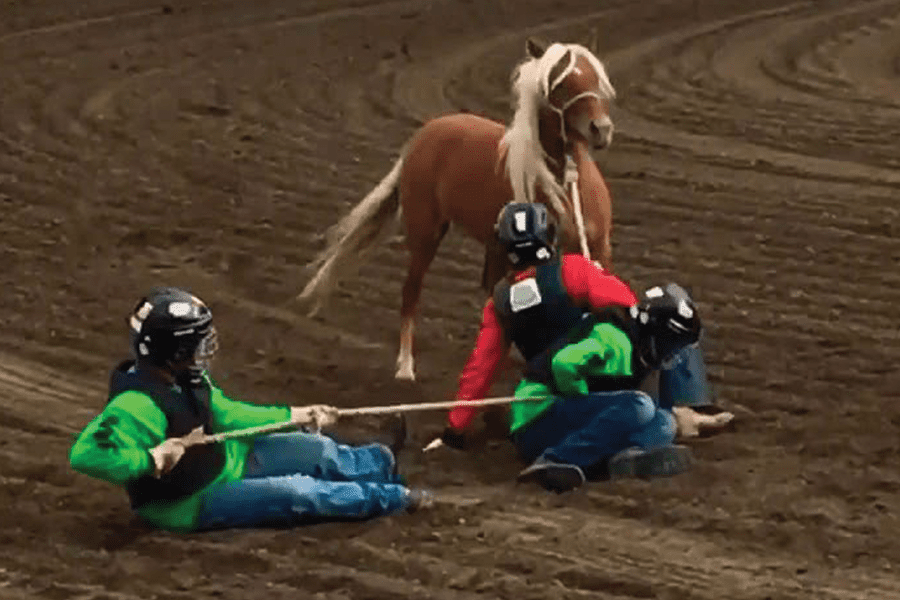
The Wild Pony Race features teams of three kids (between eight and twelve years old) who try to control and ride a wild pony. And when I say ‘wild’, that is an accurate description. These ponies want nothing to do with their would-be riders.
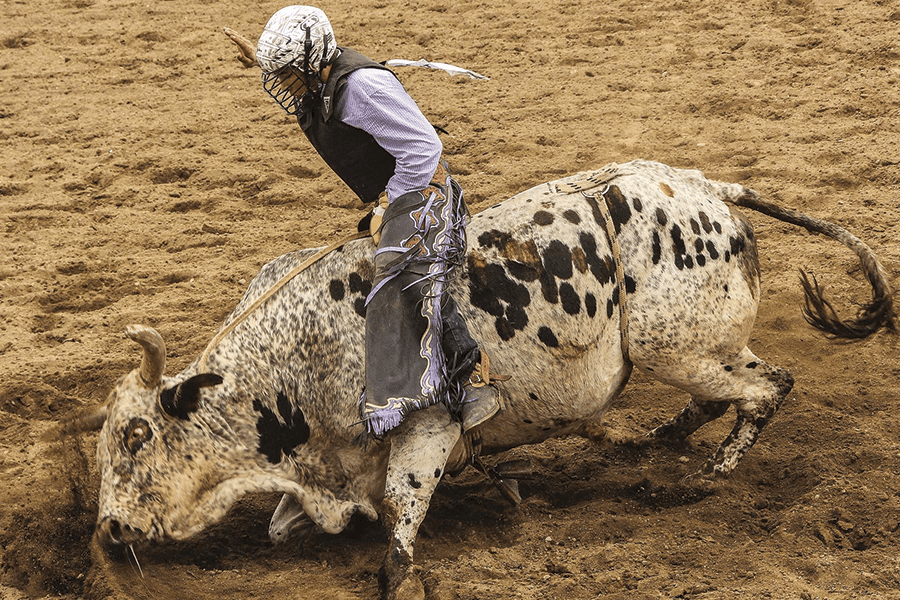
Grab your tickets for the 2023 Cochrane Rodeo today!